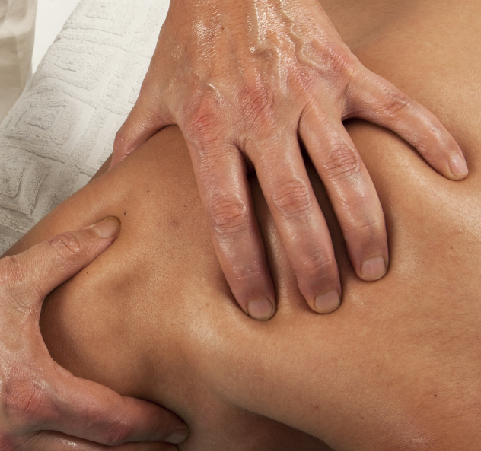The scapulothoracic joint is not a true joint in the traditional sense, as there is no bony articulation between the scapula (shoulder blade) and the thorax (rib cage). Instead, the scapula glides along the posterior thoracic wall, which is made up of the rib cage and associated musculature.
The scapulothoracic joint is an important component of normal shoulder motion, as it allows for a wide range of arm movements. The movement of the scapula is intimately linked with that of the shoulder joint proper (the glenohumeral joint), and the two joints must work together in order for normal shoulder function to occur.
Various muscles attach to the scapula and help to control its movement, including the trapezius, serratus anterior, and rhomboids. Dysfunction of these muscles can result in abnormal scapular movement and contribute to shoulder pain and dysfunction. Physical therapy and exercise programs are often used to address scapulothoracic dysfunction and improve shoulder function.

Function
The scapulothoracic joint plays an important role in shoulder movement and stability. Some of its key functions include:
Scapular rotation
The scapula rotates upward, downward, and laterally around the thorax to facilitate movement of the arm.
Scapular protraction/retraction
The scapula moves forward and backward along the thorax to enable arm movement and improve stability.
Scapular elevation/depression
The scapula moves up and down, helping to lift and lower the arm.
Scapular tilt
The scapula tilts forward and backward, which helps to maintain the proper alignment of the shoulder joint.
Stabilization
The scapula serves as a stable base for the shoulder joint, which allows the shoulder to move in a smooth and coordinated manner.
Pain
Scapular winging: This is a condition in which the scapula protrudes from the back due to weakness or paralysis of the serratus anterior muscle. This can cause pain and discomfort in the shoulder and upper back.
Shoulder impingement: This occurs when the tendons or bursa in the shoulder joint become compressed between the scapula and the humerus (upper arm bone). This can cause pain, weakness, and limited range of motion.
Thoracic outlet syndrome: This is a condition in which the nerves and blood vessels that pass through the thoracic outlet (the area between the neck and the shoulder) become compressed, causing pain, numbness, and tingling in the shoulder and arm.
Rotator cuff injury: The rotator cuff is a group of muscles and tendons that attach the scapula to the humerus. Injuries to the rotator cuff can cause pain and weakness in the shoulder and upper back.
Movements
The scapulothoracic joint allows for several movements that are important for shoulder function. Some of the main movements of the scapula include:
Upward rotation
This movement occurs when the inferior angle of the scapula moves away from the spine and upward, as in reaching overhead.
Downward rotation
This movement occurs when the inferior angle of the scapula moves toward the spine and downward, as in lowering the arm.
Protraction
This movement occurs when the scapula moves away from the spine and toward the front of the body, as in pushing or punching.
Retraction
This movement occurs when the scapula moves toward the spine and away from the front of the body, as in pulling or rowing.
Elevation
This movement occurs when the scapula moves upward toward the ear, as in shrugging.
Depression
This movement occurs when the scapula moves downward away from the ear, as in lowering the shoulders.
